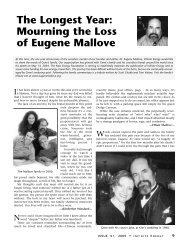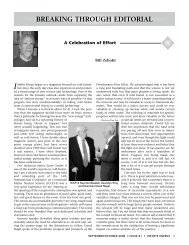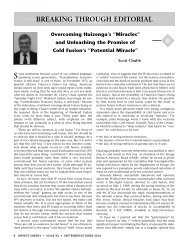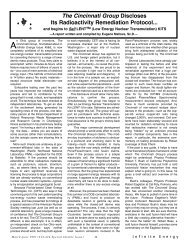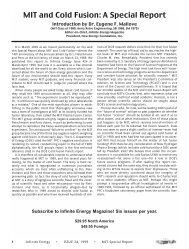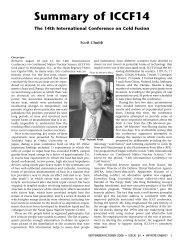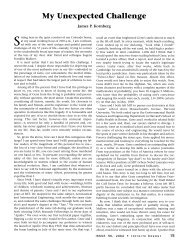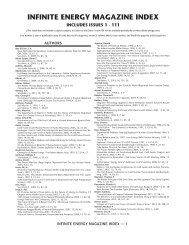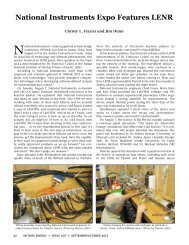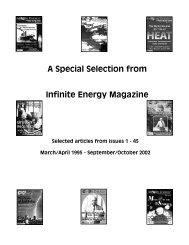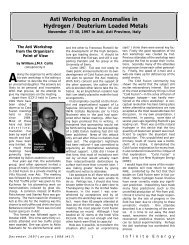Martin Fleischmann's Historic Impact - Infinite Energy Magazine
Martin Fleischmann's Historic Impact - Infinite Energy Magazine
Martin Fleischmann's Historic Impact - Infinite Energy Magazine
You also want an ePaper? Increase the reach of your titles
YUMPU automatically turns print PDFs into web optimized ePapers that Google loves.
have always remained proud of my role in EPRI’s $6.5 million<br />
investment in the SRI contract which succeeded in confirming<br />
the claims of Fleischmann and Pons but were unable<br />
to take them to a commercially useful level of reliability.<br />
After retirement in 1997, I have retained a strong interest<br />
in resolving the controversy over cold fusion. There are<br />
numerous indications, in the many research efforts spawned<br />
by the Fleischmann and Pons 1989 announcement, of other<br />
nuclear reactions besides that of the fusion of two deuterons<br />
to helium-4. I am currently intensely reviewing the literature<br />
at lenr-canr.org for evidence supporting even more surprising<br />
nuclear reactions with potentially equal or greater significance<br />
than simple deuterium fusion.<br />
Did the Fleischmann-Pons March 23, 1989 announcement<br />
change my life? You bet it did! For which I am<br />
extremely grateful. I now have a laboratory of my own to<br />
pursue the glow discharge method of loading deuterium into<br />
palladium, titanium and other hydrogen-absorbing metals.<br />
The matrix of possible combinations of metals, gas pressures,<br />
voltages and current protocols is extremely large. It is a<br />
pleasure to have something game-changing to do beyond<br />
playing bridge with my aging friends! The list of experiments<br />
is so large that it should last as long as I do even if I<br />
live to 110, as one man was reported recently to do.<br />
Dr. Jean-Paul Biberian<br />
(Editor, Journal of Condensed Matter Nuclear Science)<br />
The 1989 public announcement by Fleischmann and Pons<br />
had a dramatic impact on my life as a scientist, but also as a<br />
human being. This gave me the opportunity to work on the<br />
most challenging research there possibly is—a solution for<br />
the world energy problem. I did not start research on cold<br />
fusion right away, but did it in 1993, as soon as I realized<br />
that I could bring some contribution to the field. I have<br />
always been an enthusiastic scientist, but working in cold<br />
fusion made my life even more exciting. Thanks to <strong>Martin</strong><br />
Fleischmann, I became addicted to this endeavor.<br />
I met <strong>Martin</strong> Fleischmann at each international conference<br />
or workshop he went to, and I was always very<br />
impressed by the depth of his knowledge. He was a great scientist,<br />
and I was sad to feel that their discovery hurt him<br />
deeply. The last time I met <strong>Martin</strong> was at the Rome conference,<br />
and I had a picture taken with him. I felt it would be<br />
my last chance.<br />
Photo courtesy of J.P. Biberian<br />
Jean-Paul Biberian and <strong>Martin</strong> Fleischmann at ICCF15.<br />
9 INFINITE ENERGY • ISSUE 105 • SEPTEMBER/OCTOBER 2012<br />
I heard about <strong>Martin</strong> before cold fusion. I had been doing<br />
work in the field of surface science, and I remember when<br />
surface enhanced Raman spectroscopy was discovered and<br />
announced by him. It was an important discovery, quite<br />
unexplainable.<br />
<strong>Martin</strong> and Stan were very helpful in supporting the<br />
research on cold fusion in France. My colleague Georges<br />
Lonchampt met them several times in their laboratory in the<br />
south of France, and <strong>Martin</strong> gave him two of their Icarus 2<br />
cells, as well as all the details about how to be successful. I<br />
am therefore very grateful to him, as without his help there<br />
would be much less research on cold fusion in France.<br />
Dr. George Miley<br />
(Professor Emeritus; Nuclear, Plasma and Radiological Engineering<br />
and Electrical/Computer Engineering Departments, University of<br />
Illinois at Urbana-Champaign)<br />
I was introduced to cold fusion several days before the<br />
Fleischmann-Pons announcement when Steve Jones from<br />
BYU called me to inquire about submission of an article on<br />
it to Fusion Technology, which I was editor of. Steve said that<br />
he was not sure if I would think cold fusion was appropriate<br />
for inclusion in the journal. I asked him what cold fusion<br />
was, but did not have time to digest his comments because I<br />
had to catch a flight to Tokyo to attend a meeting. When I<br />
landed, my host from the University of Tokyo greeted me<br />
waving a copy of the Wall Street Journal which featured a<br />
main article on “fusion in a test tube.” They thought I would<br />
be able to explain this to them, but unfortunately I had not<br />
had the time to discuss it with Steve. As is well known now,<br />
Steve Jones’ research was one of the factors that caused the<br />
premature public announcement by Fleischmann-Pons. I<br />
never received the article from Steve, although I had told<br />
him to send it to me. It apparently ended up in Nature.<br />
When I returned home, a number of students in my department<br />
came to see me wanting to set up a duplication experiment.<br />
We initially did that, but later switched to different<br />
types of loading techniques based on use of plasmas which I<br />
knew more about than electrolysis. Needless to say, this<br />
experience and the initial excitement set me off on cold<br />
fusion research (which I now term low-energy nuclear reactions,<br />
or LENR, due to involvement of transmutation reactions).<br />
I was convinced that this area of nuclear reactions in<br />
solid state deserved basic study, so was not deterred when<br />
many claimed that the Pons/Fleischmann experiment did<br />
not work.<br />
The first time I met <strong>Martin</strong> Fleischmann was actually in<br />
the initial congressional hearing held shortly after their<br />
announcement. The purpose of this hearing was to help<br />
Congress decide if this discovery warranted a national program<br />
to develop the technology. The congressional assistant<br />
who called me to serve on the hearing said they wanted<br />
someone recognized for innovative research and an open<br />
mind, not someone who was already involved in the area. I<br />
agreed. As it turned out, I was placed in the hearing between<br />
testimonies by <strong>Martin</strong> and Harold Furth. At the time Harold<br />
was head of the Princeton Plasma Physics Laboratory, and<br />
since I had been working on hot fusion I knew him reasonably<br />
well. Harold was dead set against cold fusion, having<br />
learned that duplication experiments were generally failing<br />
and fearing that work on it could take funds from the hot



